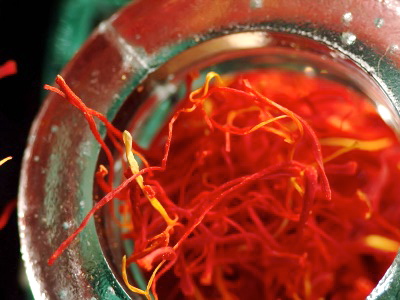
feature-image, l
(article, Melissa Lion)
[%pageBreakSettings nobreak=true] Okay, I’ll admit it: I’m a little freaked out about savory things being sweet. I can’t be the only person in the world who hesitates at the thought of cinnamon or dried fruit with my chicken. I enjoy it when I’ve had it at restaurants, but I’d never cooked that way at home. Then a North African and a Middle Eastern cookbook came my way, and I needed to break out the cinnamon and dried fruit real fast. And buy some saffron, which is, in a word, expensive. [[block(sidebar). h1.Featured recipes]] As with most things in my culinary life, I had a tiny feeling that Middle Eastern food would require more money and brain cells and bravery than most of my cooking, but I ignored it. When I found myself facing two dinner parties in a row, I decided to make North African food for one and Middle Eastern food for the next. What the hell, I told myself. Go for it. For the first dinner party, I cooked from The North African Kitchen, by Fiona Dunlop. This cookbook is organized by city — Marrakech, Fez, Tunis, Carthage, La Goulette, and Tripoli. If you want to cook from this book, you’ll need raisins. A lot of raisins. The recipes are straightforward and, in most cases, require little more than your regular cooking tools. Except for the Couscous m’Hassel (Sweet Chicken Couscous), which I made for my first dinner party. It seemed pretty easy at first — chicken, couscous, raisins. I can do that. But it also called for crushed saffron. Somewhere in my brain, I thought, “Crushed saffron? That must be the easier-to-find and less-expensive version of regular saffron.” At the grocery store I discovered that, unlike tea or most spices, crushed or ground or broken-into-bits saffron is just as pricey as the long threads. And the recipe called for three teaspoons of the stuff, and no way was there three teaspoons in the little packet from the grocery store. But I bought it and figured I’d wing it. The recipe says the chicken, all three pounds of it, should be steamed. I’m willing to cook a sweet dinner, but not willing to force my guests to consume flabby, bland chicken. So I pan-roasted the thighs to get crispy skin and deep flavor. I sautéed the raisins and the onions. I made the couscous according to the directions on the package and not the directions in the cookbook, which involved several 15-minute trips through a contraption called a couscoussière. The result was a great, easy dinner. The pan-roasted chicken provided a nice savory counterpoint to the sweet raisins and onions. I used less saffron than it called for, but cinnamon and ginger were a great compliment to the dish. The recipe is a keeper and certainly a go-to meal for those weeknights when the same old is just plain old and the family dinner needs a little pep. Next night I was cooking again, and though my pans smelled like cinnamon — a disconcerting result of dinner the night before — I was ready to cook from Artichoke to Za’atar, by Greg and Lucy Malouf. This cookbook is oddly organized. It’s alphabetical by ingredient, which results in chapters where appetizers and sauces are next to main dishes or light lunches. Not exactly the simplest method for a cook who just needs dinner. The headlining ingredients range from spices (cinnamon, yet again) to fruit (quince) to beverages (Turkish coffee gets its own chapter). The book’s recipes are also oddly broad, with British dishes such as Garlic Yorkshire Pudding alongside traditional Middle Eastern dishes such as Tunisian Briks With Brains. Nevertheless, the majority of the recipes focus on fresh ingredients and simple preparations. I chose to make the White Bean Soup with Spicy Merguez Sausage, because who doesn’t like white-bean soup? But I didn’t know what merguez sausages were. I assumed the guys behind the meat counter at the posh market would know — but they didn’t. I could have looked it up online before heading out, and that would have been a good back-up plan, but no. [%image feature-image float=left width=350 caption="Buy saffron in threads, not powder."] My back-up plan was shrugging and buying some chorizo. I figured the white-bean soup would call for something spicy, and I was right. Okay, not right at all; merguez sausage is spicy, yes, but it’s a combination of lamb and beef, not pork. (Note to self: Despite the bacon called for in this dish, pork is not likely to be a major ingredient in Middle Eastern dishes.) The soup calls for lemon zest, honey, hazelnut oil, and a garnish of hazelnuts. The result is a light, fresh soup with a slight heartiness due to the nuts and the sausage sprinkled on top. I used the immersion blender on it for a creamier base. My guests were a little skeptical about the hazelnuts, but in the end, we were scraping the pot for the rest. It was a delicious treat. The lemon gives the soup a good summery boost, but in winter it’ll make a great meal. Intimidating at first, both cookbooks stretched my culinary knowledge and opened up new recipes and influences to draw from for weeknight meals. As Greg Malouf writes, “While some of the dishes might sound exotic and mysterious, they are based on traditions which are, after all, everyday fare in another culture.” p(bio). Melissa Lion is the author of two novels, [%bookLink code=0385746423 Swollen] and [%bookLink code=0375839542 Upstream]. She lives in Portland, Oregon, and blogs about extremely personal things very publicly on her website.

feature-image, l

reference-image, l